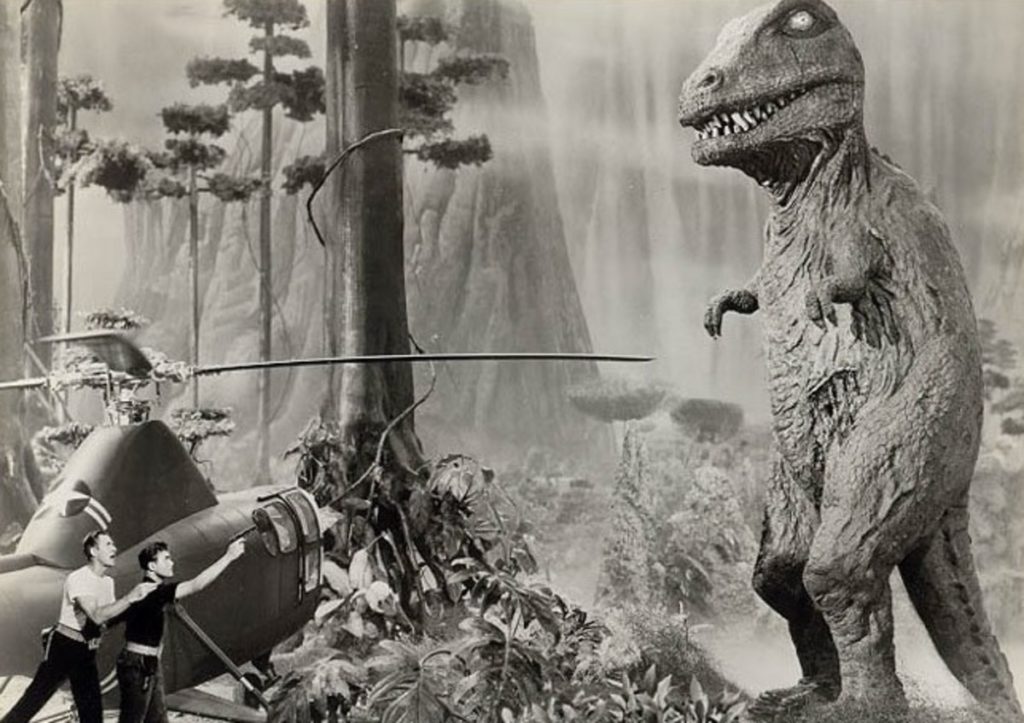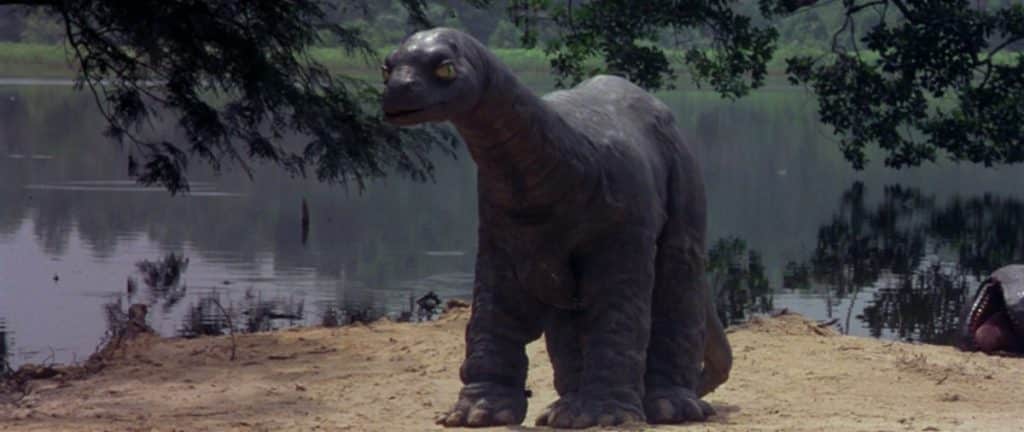Read also:
How to Watch FX Live Without CableHow To Watch AMC Without CableHow to Watch ABC Without CableHow to Watch Paramount Network Without CableKinoKultur is a thematic exploration of the queer, camp, weird, and radical releases Kino Lorber has to offer.
Dinosaurs are the ultimate symbols of The Past. They represent deep time, natural history, and the chaos of the wild. It’s no wonder that cinema has always been fascinated by them. One of the first exhibitions of what we might now call “cinema” was presented in 1922 by Sherlock Holmes’ own Sir Arthur Conan Doyle, “footage of moving dinosaurs” from the exhibition at the center of his 1912 novella, The Lost World. From the very beginning of the medium, creatives have sought to reanimate the awesome creatures on the silver screen.
When dinosaurs appear on film, they frequently bring with them a host of cultural and ideological anxieties. Dinosaurs threaten humanity’s imperial dominance on the planet. When they appear, we become prey. And they remind us that even the mightiest powers can be reduced to dust.
Cinematic dinosaurs are a deep reminder that humanity’s capabilities have very real limits—that we cannot sufficiently replicate Nature. The image of the dinosaur remains queerly elusive in that regard; the long shadow they cast is one constantly being reshaped by new scientific and cinematic discoveries.
Kino Lorber’s catalog boasts two examples of dinosaur pictures that are fascinating for these and other reasons—The Land Unknown (1957) and Baby: Secret of the Lost Legend (1985). Both films are colonial Lost World tales, centering on a remote “primitive” area of the globe that has been “untouched” by time — Antarctica and Africa, respectively. Each film, in its own way, blends reality and fantasy. But both are most famous for their unbelievable dinosaurs.
Creature suit performances have been and remain a staple method of practical monster effects. They allow the monster to interact with the scenery and their castmates in a tangible way, one that cannot quite be matched by other methods. The goal of creature and creature suit designers is to hide the human form while making the inhuman character the suit actor is performing feel real.
Neither The Land Unknown nor Baby achieves this. The rubber and whatever other materials used in the suit building instead call attention to the fact that this is indeed NOT a dinosaur. Instead of creating a pseudo-reality, the result is a more blatant suit-o-reality. But, while these costumes may be “unrealistic” in the sense that they don’t resemble our accepted image of a “real” dinosaur, The Land Unknown and Baby‘s dinosaurs nonetheless highlight real truths buried under the films’ surfaces.

The Land Unknown has everything you’re looking for in a 1950s B-movie: clippy dialogue, miniatures, problematic gender relations, actors named Jock, and, of course, early special effects. Directed by Virgil Vogel, the film follows a scientific military expedition to the Arctic, allegedly home to a lush oasis untouched by humanity. Commander Roberts (Jock Mahoney) and Margaret Hathaway (Shirley Patterson) are on route to this haven with a small crew when their helicopter is downed by a pterosaur. The crew manages to make an emergency landing inside the wild wonderland and must fight to survive amongst its prehistoric flora and fauna while repairing the damaged chopper that can take them to safety.
The Land Unknown began as a full-blown A-picture, meant for a large budget and huge stars. But the project continually changed hands, its budget bled, and ultimately it was unceremoniously demoted from main feature standing. B the time The Land Unknown‘s team was ready to begin shooting, they had a fabulous backdrop, detailed miniatures, and a working plesiosaur, but not enough money for big names, color film, or any other special effects. Monitor lizards replace fighting dinosaurs and the T-Rex that does appear is a man in a shabby, goopy-looking suit (suggesting, perhaps, the secret origin of Rugrats‘ Reptar). Far from being distracting, these make-the-most-of-what-we’ve-got effects add to the film’s charm. Yes, they’re silly, but they’re also a reminder about the realities of filmmaking.
As Tom Weaver highlights in his wildly entertaining and insightful commentary track, B pictures like The Land Unknown showcase the working-class section of Hollywood that always underwrote major productions during the Studio Era. They were films on which laboring folks had to make do with the minuscule budgets they were given. The unknown performer wearing the Rex suit was, like his peers on The Land Unknown‘s crew, a journeyman who worked gig to gig, rarely recognized beyond cult audiences in their lifetimes.
Baby: Secret of the Lost Legend, on the other hand, is the polar opposite. An early release from The Disney Corporation’s then newly-minted live-action film company, Touchstone Pictures, it boasts a sizable budget, stars like Sean Young (still riding Blade Runner fame), elaborate sets, location shooting, and large scale emotive animatronics. Yet, like its less monied ancestor, Baby‘s puppetry fails to conceal the person inside the suit.
Dr. Susan Loomis (Sean Young) stands at the heart of this Disneyventure. During a research expedition to Africa, she is asked to treat a village whose members have all fallen mysteriously, violently ill. Allegedly, the sickness sprang from eating the mythical mokele-mbembe monster. On their hunt for answers, Dr. Loomis and her team find a happy living family of Brontosaurus, a father, a mother, and a baby whom they inventively dub Baby. Alas, terror and tragedy stalk the dino family, a soon Dr. Loomis must face the impossible task of rescuing Baby from captivity before any more death comes to the area.
Like The Land Unknown, Baby boasts some sparkling, if morbid, effects. An animatronic brontosaur perishes in a brutal and heartbreaking death right before our eyes. There’s a disarming amount of pain conveyed through the doomed dino’s remote-control eyes, and it invokes the pathos necessary for the audience to support Dr. Loomis’ taking it upon herself to liberate Baby.
As for Baby, trotting about with his padded body barely covering the outline of the human hunched over inside, his foam longneck bouncing this way and that, he’s naively cute.

Both of these films feature Americans taking “benevolent” control of a so-called “wild” area, be it a newly “discovered” oasis in the Arctic for scientific research or a small swath of central Africa for humanitarian aid. The Land Unknown and Baby: Secret of the Lost Legend demonstrate and rehearse American exceptionalism—its intellectual, charitable, and cinematic prowess—naturalizing its authority anywhere it goes.
Yet, for all their efforts, in bumbles a man in a dubious dinosaur costume. We shouldn’t let this take us out of the movie. Indeed, the questionable outfits should anchor our enjoyment. The man in the questionable dino suit becomes the man behind the curtain, making plain the realities behind what we’re seeing. We can begin to ask questions like: If this crucial character, for all their stuffing and padding, is still recognizably human inside, what other parts of the film might be papering over humanity?
From there we can begin to excavate the ideas of dominance, sovereignty, and resource control that are fossilized deep inside these narratives. Lost Worlds themselves are cheap miniatures and backdrops in an imperial playground. They are deceptively simple motifs that allow a host of violent histories and ideas to repeat themselves. Because of their “primitive” or “untouched” state, we can see the narratives of colonialism pour in almost immediately.
The man in the questionable dino suit becomes the man behind the curtain, making plain the realites behind what we’re seing.
Dinosaurs are one of the ultimate symbols of the past. They must be conquered, contained, or controlled (through violence or study). By taming, taxonomizing, or killing these “beasts,” the characters in these films restore a “natural order” with white Western folks once again on top of nature and all those who live with and within it.
Yet, all these grand and lofty proclamations are undermined by the silliness of these fearsome foes. Gone is any possibility for a complete takeover of reality. The Land Unknown and Baby‘s dinosaurs can instead serve as a compass for reading these pictures against their grain. The stuffed suits can be a guide to the strawman rhetorics used to bloat the white savior complex while decrying less “intelligent” and “capable” indigenous peoples and plants.
It’s tempting to dismiss these films because their dinosaurs are “unrealistic.” But realism does not just mean being convincing to the eye. It can also mean being genuine, revealing a truth, and intentionally or otherwise, both of these dino films do so. They reflect the working-class realities of the film industry, the necessity of getting work DONE even amidst budget restraints and. And less directly but no less importantly, they embody and represent the overstuffed patchwork of colonial ideals that are sewn deep into Lost World dinosaur films.